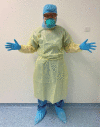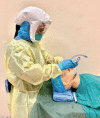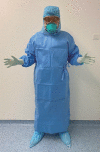In the Extraordinary Times of Coronavirus Disease 2019: Clinical Strategies for Performing Spinal Surgery
- PMID: 32872763
- PMCID: PMC7595824
- DOI: 10.31616/asj.2020.0306
In the Extraordinary Times of Coronavirus Disease 2019: Clinical Strategies for Performing Spinal Surgery
Abstract
The coronavirus disease 2019 (COVID-19) pandemic has caused pronounced strain on global healthcare systems, forcing the streamlining of clinical activities and conservation of health resources. There is a pressing need for institutions to present discipline-specific strategies for the management of COVID-19 patients. We present the comprehensive considerations at the National University Hospital, Singapore from the surgeon's and anesthetist's perspectives in the performance of spinal surgery in COVID-19 patients. These are based on national guidelines and overarching principles of protection for the healthcare workers (HCWs) and efficiency in surgical planning. The workflow begins with the emergency department screening that has been adapted to the local epidemiology of COVID-19 in order to identify suspected/confirmed cases. If patient history cannot be obtained, demographic, clinical, and imaging data are used. Designated orthopedic "contaminated teams" are available 24/7 with an activation time of <30 minutes for review. In cases where sub-specialty spine surgeons were required, these professionals were inducted into the "contaminated team" and quarantined until cleared to return to work. Indications for emergency spine surgery were determined pre-emptively. Preoperative surgical considerations included the minimization of manpower, limited dissection, reduced operative time, and judicious use of equipment, leading to reduced aerosolization. Anesthesia considerations include preoperative screening for COVID-19-related concerns that influence surgery, operating room process planning and induction, intraoperative, reversal, recovery, and resuscitation considerations. Focused multi-disciplinary preoperative briefing facilitates familiarization. Surgical, anesthetic, and postoperative workflows were designed to reduce the risk of transmission and protect HCWs while effectively performing spinal surgery. The COVID-19 pandemic has necessitated paradigm shifts in healthcare planning, hospital workflows, and operative protocols. The viral burden does not discriminate between surgeons and physicians, and it is crucial that we, as medical professionals, adapt practices to be malleable and fluid to address the ever-changing developments.
Keywords: Anesthesia methods; COVID-19; Hospital planning; Operative surgical procedures; Perioperative procedures; Personal protective equipment; Spine surgery.
Conflict of interest statement
No potential conflict of interest relevant to this article was reported.
Figures




References
-
- Londono E, Andreoni M, Casado L. The New York Times [Internet]; Bolsonaro, isolated and defiant, dismisses coronavirus threat to Brazil. 2020 Apr 1 [cited 2020 Jul 22]. Available from: https://www.nytimes.com/2020/04/01/world/americas/brazil-bolsonaro-coron....
-
- The Economic Times . The Economic Times [Internet]; Merkel calls coronavirus ‘biggest challenge since WWII’. 2020 Mar 19 [cited 2020 Jul 22]. Available from: https://economictimes.indiatimes.com/news/international/world-news/merke....
-
- Center for Systems Science and Engineering . COVID-19 dashboard by the Center for Systems Science and Engineering (CSSE) at Johns Hopkins University (JHU) Baltimore (MD): Coronavirus Resource Centre, Johns Hopkins University and Medicine; 2020.
-
- Emanuel EJ, Persad G, Upshur R, et al. Fair allocation of scarce medical resources in the time of Covid-19. N Engl J Med. 2020;382:2049–55. - PubMed
LinkOut - more resources
Full Text Sources

